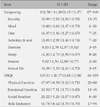Abstract
Purpose
The purpose of this study was to investigate the relationship of Yangsaeng and HRQOL in middle aged women. Yangsaeng as a traditional health care regimen for the promotion of health and prevention of illness by means of specific principles and methods, which purpose was to improve longevity and healthy life.
Methods
The subjects of this study were 200 middle aged women in Korea. Data were collected by using a self-reported questionnaire and analyzed through descriptive statistics, Pearson's correlation coefficient, t-test, ANOVA and multiple linear regression.
Results
There was statistically significant difference in Yangsaeng according to age, stress and working hours. There were significant differences in HRQOL according to stress and working hours. The relationship between Yangsaeng and HRQOL had a significant positive correlation. Mind and diet Yangsaeng, christianity, and working hours were found to be significant predictors (24.6%) of HRQOL.
Figures and Tables
References
1. Ahn H.M., Kim S.S., Kim W.G., Yu H.D., Chong M.S., Lee K.M. A study on the relations between yangseng level and stress in industrial workers. Journal of Korean Medical Gi-Gong Academy. 2007. 10(1):100–129.
2. American College of Sports Medicine. ACSM's guidelines for exercise testing and prescription. 2006. 7th ed.Mc Baltimore: Lippincott Williams & Wilkins.
3. Choi B.N., Kim S.H., Yook D.W. The relationship between quality of life and coping with stress for middle age women in dance sports. Korean Journal of Sport Science. 2009. 20(3):517–530.
4. Chon M.Y., Ryu E.J., Yeon E.J. Subjective fatigue and coping types between middle aged adults and elders. Journal of Korea Community Health Nursing Academic Society. 2001. 15(2):387–397.
5. Ferrans C.E. Yarbro C., Frogge M., Goodman M, editors. Quality of life as an outcome of cancer care. Cancer nursing: Principles and practice. 2005. 6th ed. MA: Jones and Bartlett.
6. Jin E.H. A study on health related action rates of dietary guidelines and pattern of dietary in middle-aged women. Journal of the Korean Society of Health Information and Health Statistics. 2009. 34(2):165–176.
7. Kim A.J. Development of a tool in measuring yangsaeng. Journal of Korean Academy of Nursing. 2004. 34(5):729–738.

8. Kim A.J. QQL-BREF and yangsaeng in Korean adult. Journal of East-West Nursing Research. 2008. 14(2):8–15.
9. Kim A.K., Kim J.A. Lifestyle characteristics and health related quality of life in Korean adult. Journal of Korean Academy of Adult Nursing. 2005. 17(5):772–782.
10. Kim A.K. Coping pattern of menopause in middle aged women. Journal of Korean Academy of Fundamentals Nursing. 2010. 17(1):35–44.
11. Kim H.S., Park R.J., Jung H.Y. Sleep yangsaeng. Journal of Korean Medical Gi-Gong Academy. 2002. 6(1):128–149.
12. Kim Y.H., Ha E.H., Shin S.J. A study on the menopausal symptoms and quality of life in middle aged women. Journal of Korean Academy of Nursing. 2003. 33(5):601–608.

13. Kim J.W., Kwon S.H., Kim A.J., Seo M.H., Park J.S., Lee K.N. Level of yangseng by certain elderly people in connection with their perception of health. Journal of Korean Medical Gi-Gong Academy. 2005. 8(10):115–127.
14. Kim K.S., Kim E.J., Lee C.Y., You M.A., Kim B.J., Park S.H., et al. Obesity related factors in middle aged women: Comparison of body mass index and/or waist circumferences as measure of obesity. Journal of Korean Academy of Public Health Nursing. 2009. 23(2):273–284.
15. Kim K.W., Kim A.J. Yangsaeng and quality of life (WHOQOL-BREF) in adult and elderly Koreans practicing dan jeon breathing (DJB). Journal of Korean Academy of Fundamentals Nursing. 2010. 17(2):231–239.
16. Korea Institute for Health and Social Affair. 2005 National Health and Nutrition Survey. 2006. Seoul:
17. Lee K.H., Chang C.J., Yoo J.H. A study on the relationship among climacteric symptoms, knowledge of menopause and health promoting behavior in middle-aged women. Korean Journal of Women Health Nursing. 2003. 9(4):400–409.

18. Lerner D.J., Levine S., Malspeis S., Agostino R.B. Job strain and health related quality of life in a nationalsample. American Journal of Public Health. 1994. 84(10):1580–1585.
19. Martin T., John R., Kim N. Diagnosis and treatment of sleep disorder. 2001. Seoul: Hana.
20. Annual report on the cause of death statistics. National Statistical Office. 2008. Retrieved July 28, 2010. from
http://www.kihasa.re.kr/html/jsp/info/info_03_view.jsp?currPage=5&dl=1&d2=1&d3=1&seq=3&seq=.
21. Nunnaly J.C., Bernstein I.H. Psychometric theory. 1994. 3rd ed. NY: McGraw-Hill.
22. Park H.S., Kim A.J. Relationship of stress, depression and yangsaeng in Korean college women. Korean Parent-Child Health Journal. 2008. 11(2):149–159.
23. Park H.S., Kim A.J. Adaptation to menopause and use of yangsaeng in middle aged Korean women. Korean Journal of Women Health Nursing. 2010. 16(1):1–9.
24. Park Y.R., Son Y.J. Relationship of satisfaction with appearance, self-esteem, depression, and stress to health related quality of life in women across the lifespan. Journal of Korean Academy of Fundamentals Nursing. 2009. 16(3):353–361.
25. Shin H.C. The definition of health related quality of life. Journal of the Korean Academy of Family Medicine. 1998. 19(11):1008–1015.
26. Son Y.J. The Influencing factors on health related quality of life (HRQOL) in married working women. Journal of Korean Academy of Adult Nursing. 2007. 19(3):422–435.
27. Statistics Korea. 2008.
http://kostat.go.kr/?method=view&board_id=144&seq=6&num=6&parent_num=0.
28. Ware J.E., Kosinski M., Dewey J.E., Gandek B. How to score and interpret single item health status measure: A manual for users of the SF-8 health survey. 2001. Lincolin, RI: Quality Metric Incorportated.
29. Women's Health Nursing Curriculum Inquiry Group. Women's health nursing care. 2010. Seoul: Soomoonsa.




 PDF
PDF ePub
ePub Citation
Citation Print
Print






 XML Download
XML Download